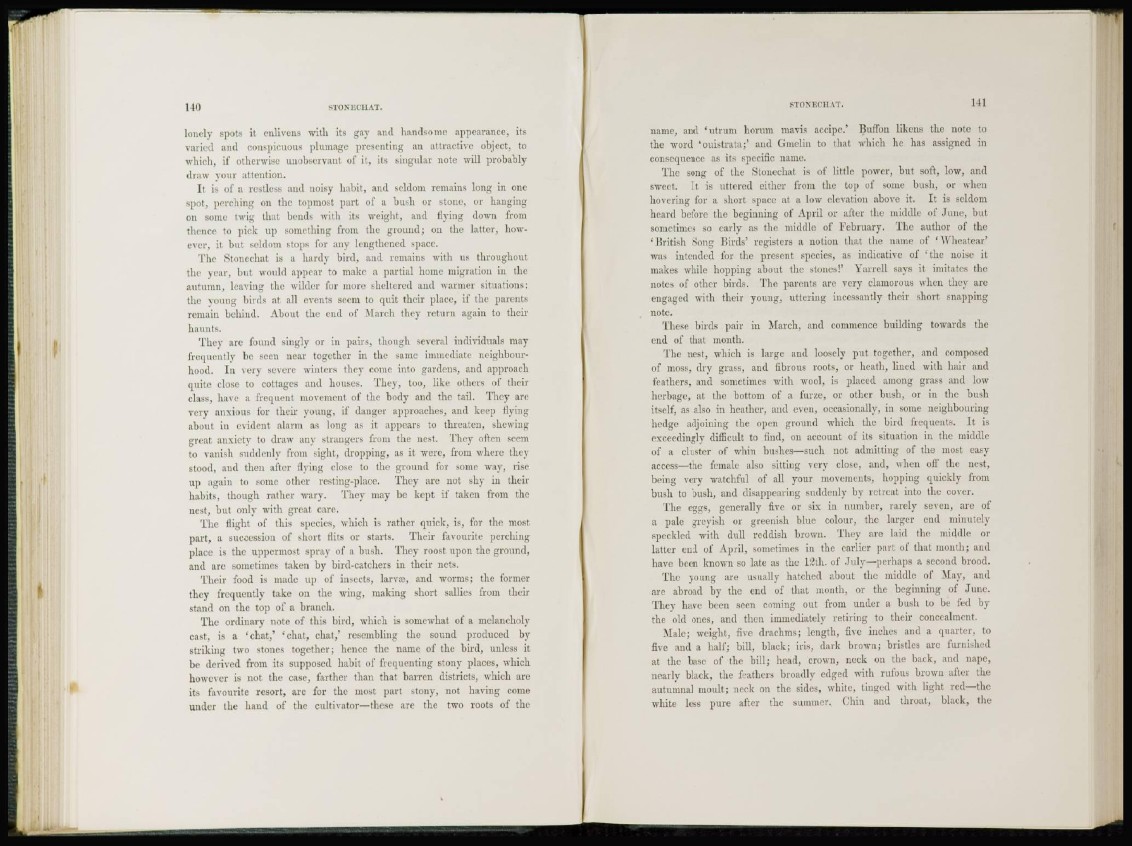
lonely spots it enlivens with its gay and handsome appearance, its
varied and conspicuous plumage presenting an attractive object, to
which] it' otherwise unobservant of it, its singular note will probably
draw your attention.
It is of a restless and noisy habit, and seldom remains long in one
spot, perching on the topmost part of a bush or stone, or hanging
on some twig that bends with its weight, and flying down from
thence to pick up something from the ground; on the latter, however,
it but seldom stops for any lengthened space.
The Stonechat is a hardy bird, and remains with us throughout
the year, but would appear to make a partial home migration in the
autumn. Leaving the wilder for more sheltered and warmer situations:
the young birds at all events seem to quit their place, if the parents
remain behind. About the end of March they return again to their
haunts.
They arc found singly or in pairs, though several individuals may
frequently he seen near together in the same immediate neighbourhood.
In very severe winters they come into gardens, and approach
quite close to cottages and houses. They, too, like others of their
class, have a frequent movement of the body and the tail. They are
v e r y anxious for their young, if danger approaches, and keep flying
about in e\ident alarm as long as it appears to threaten, shewing
great anxiety to draw any strangers from the nest. They often seem
to vanish suddenly from sight, dropping;, as it were, from where they
stood, aud then after flying close to the ground for some way, rise
up again to some oilier resting-place. They arc not shy in their
habits, though rather wary. They may be kept if taken from the
nest, but only with great care.
The flight of this species, which is rather quick, is, for the most
part, a succession of short flits or starts. Their favourite perching
place is the uppermost spray of a bush. They roost upon the ground,
and are sometimes taken by bird-catchers in their nets.
Their food is made up of insects, larvae, and worms; the former
they frequently take on the wing, making short sallies from their
stand on the top of a branch.
The ordinary note of this bird, which is somewhat of a melancholy
cast, is a ' chat,' ' chat, chat,' resembling the sound produced by
striking two stones together; hence the name of the bird, unless it
be derived from its supposed habit of frequenting stony places, which
however is not the case, farther than that barren districts, which are
its favourite resort, are for the most part stony, not having come
under the hand of the cultivator—these are the two roots of the
name, and ' u t r um horum mavis accipo.' Buffon likens the note to
the word * ouistrata;' and Gmelin to that which he has assigned in
consequence as its specific name.
The song of the Stonechat is of little power, but soft, low, and
sweet. It is uttered either from the top of sonic bush, or when
hovering for a short space at a low elevation above it. It is seldom
heard before the beginning of April or after the middle of J u n e , but
sometimes so early as the middle of February. The author of the
'British Song Birds' registers a notion that the name of ' Wheat ear'
was intended for the present species, as indicative of ' t h e noise it
makes while hopping about the stones!* Yarrell says it imitates the
notes of other birds. The parents are very clamorous when they are
engaged with their young, uttering incessantly their short snapping
note.
These birds pair in March, and commence b u i l d i n g towards the
end of that month.
The nest, which is large and loosely put together, and composed
of moss, dry grass, and fibrous roots, or heath, lined with hair and
feathers, and sometimes with wool, is placed among grass and low
herbage, at the bottom of a furze, or other bush, or iu the bush
itself, as also in heather, and even, occasionally, in some neighbouring
hedge adjoining the open ground which the bird frequents. It is
exceedingly difficult to find, ou account of its situation in the middle
of a cluster of whin bushes—such not admitting of the most easy
access—the female also sitting very close, and, when off the nest,
being very watchful of all your movements, hopping quickly from
bush to bush, and disappearing suddenly by retreat into the cover.
The eggs, generally five or six in number, rarely seven, are of
a pale greyish or greenish blue colour, the larger cud minutely
speckled with dull reddish brown. They are laid the middle or
latter cud of April, sometimes in the earlier part of that month; and
have been known so late as the 13th. of July—perhaps a second brood.
The young are usually hatched about the middle of May, and
are abroad by the end of that month, or the beginning of June.
They have been seen coming out from under a bush to be fed by
the old ones, and then immediately retiring to their concealment.
Male; weight, five drachms; length, five inches and a quarter, to
five and a half; bill, black; iris, dark brown; bristles are furnished
at the base of the bill; head, crown, neck on the back, and nape,
nearly black, the feathers broadly edged with rufous brown after the
autumnal moult; neck on the sides, white, tinged with light red—the
white less pure after the summer. Chin and throat, black, the